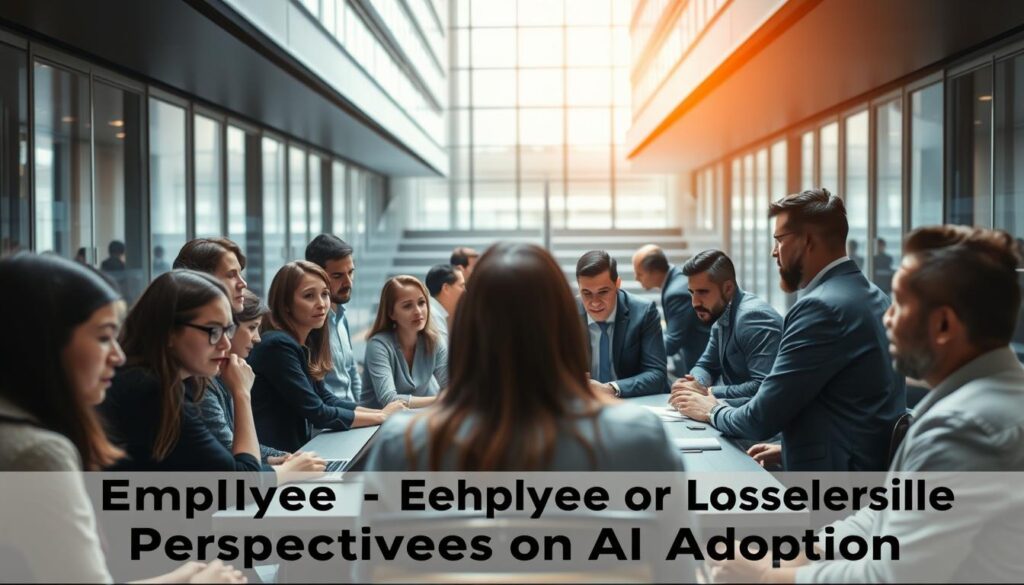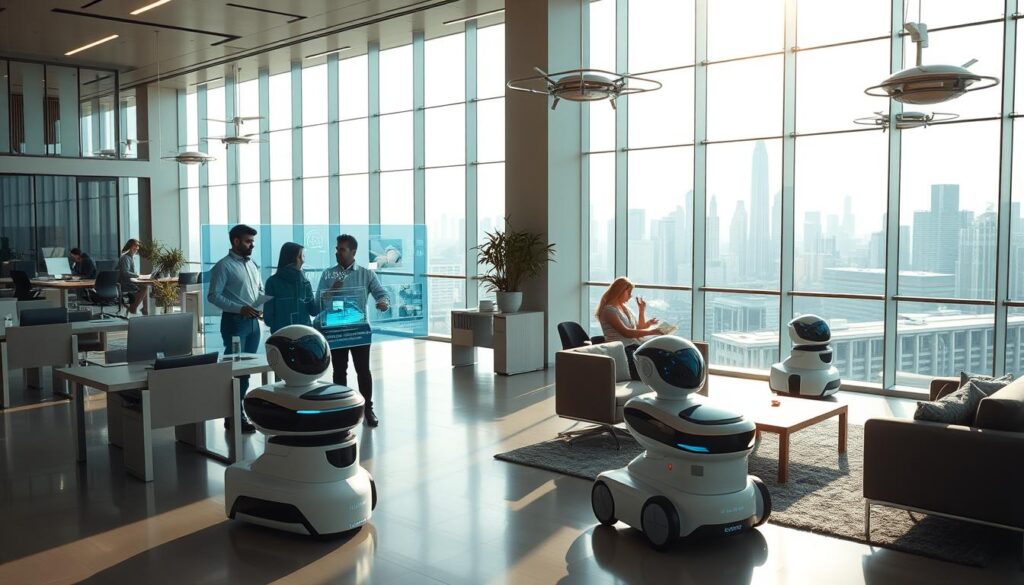“Technology is nothing. What’s important is that you have faith in people, that they’re basically good and smart, and if you give them tools, they’ll do wonderful things with them.” – Steve Jobs. This quote captures the essence of how advanced tools, like AI agents, are reshaping the future of industries and workflows.
By 2025, these intelligent systems are set to revolutionize how businesses operate. From automating repetitive tasks to enhancing decision-making, AI agents are becoming indispensable. Companies are already seeing significant improvements in efficiency and productivity. For example, BMW’s multi-agent collaboration framework has enhanced operational flexibility1.
Innovation in this space is accelerating. With open-source models, even small businesses can now access cutting-edge AI capabilities. This democratization of technology is leveling the playing field, allowing companies of all sizes to compete effectively. For instance, Elkem Silicones improved conversion rates by 40% using AI-driven lead management1.
As industries adapt, the potential for growth is immense. Organizations that embrace these changes early will gain a competitive edge. The future belongs to those who leverage AI agents to streamline workflows and drive innovation.
Key Takeaways
- AI agents are revolutionizing workflows across industries.
- Open-source models make advanced AI accessible to small businesses.
- Companies like BMW and Elkem Silicones are already benefiting.
- Early adopters gain a significant competitive advantage.
- Efficiency and productivity improvements are measurable and impactful.
Introduction to the New AI Landscape in 2025

A new era of technology is reshaping business operations globally. Over the past two years, breakthroughs in large language models and multimodal capabilities have accelerated innovation. These advancements are redefining the landscape of industries, making intelligent tools more accessible and impactful than ever before.
Large language models, like GPT-4 and beyond, are at the forefront of this revolution. They enable agents to process vast amounts of information, making them invaluable for decision-making and automation. For example, Intercom’s AI customer service agent, Fin, has resolved over 13 million queries, showcasing the potential of these tools2.
This shift is pivotal for business operations. Companies are now focusing on quantifiable ROI from AI investments, ensuring cost efficiency while driving productivity3. The global AI agents market is projected to grow from $5.1 billion in 2025 to $47.1 billion by 2030, reflecting a compound annual growth rate of 44.8%2.
Overview of Technological Advancements
Recent advancements include the development of specialized AI models tailored to specific industries. For instance, BloombergGPT is transforming finance, while Med-PaLM 2 is revolutionizing healthcare3. These models are not only enhancing efficiency but also addressing workforce shortages, such as the 2.1 million unfilled jobs projected in US manufacturing by 20303.
The Importance of This Revolution
This technological revolution is critical for staying competitive. Companies that adopt these tools early will gain a significant edge. For example, AI agents are automating 75% of resume screening tasks in HR, streamlining hiring processes2. Additionally, they are improving predictive analytics in healthcare, with 90% of hospitals expected to adopt AI agents by 20252.
As the landscape evolves, businesses must adapt to remain relevant. Those that leverage these advancements will not only enhance productivity but also drive long-term growth. To learn more about how AI is transforming finance, visit this detailed analysis.
Evolution of AI: From LLMs to Autonomous Agents

From basic algorithms to autonomous systems, AI has come a long way. The evolution of this technology has been driven by significant milestones and innovations. Early models focused on rule-based systems, but today’s agents are capable of learning and adapting independently.
Historical Milestones in AI Development
The shift from GPT-3.5 to GPT-4 marked a major leap in natural language processing. These models expanded context windows and improved reasoning capabilities. For example, GPT-4 can analyze complex datasets with 90% accuracy, making it a game-changer in decision-making4.
Another milestone was the introduction of multimodal functionalities. Systems like Med-PaLM 2 now process text, audio, and visual data, enhancing their versatility. This evolution has paved the way for more advanced applications in healthcare and finance5.
Key Innovations Driving Change
Expanded context windows have allowed agents to handle larger datasets efficiently. For instance, BloombergGPT processes financial data with unprecedented speed, improving market analysis6.
Reinforcement learning has also played a crucial role. Autonomous systems now learn from interactions, optimizing their strategies over time. This process has been particularly effective in logistics and self-driving technologies4.
Finally, the rise of multi-agent systems has revolutionized complex environments. These systems collaborate to achieve objectives, boosting operational efficiency by up to 35%6.
The Rise of AI Agents in 2025: Transforming Industries and Workflows

Autonomous systems are becoming a cornerstone of modern workflows. Unlike traditional AI assistants, agentic AI operates independently, executing complex tasks with minimal human intervention. These systems are designed to handle entire workflows, not just isolated tasks, making them a game-changer for industries.
Defining Agentic AI and Its Capabilities
Agentic AI refers to systems that can learn, adapt, and act autonomously. Unlike rule-based models, these agents analyze data, make decisions, and execute tasks without constant oversight. For example, Salesforce’s Agentforce uses agentic AI to streamline customer service, reducing response times by 40%7.
These systems excel in handling complex workflows. They can manage everything from data analysis to task execution, ensuring seamless operations. In healthcare, agentic AI automates administrative tasks like appointment scheduling, freeing up clinicians to focus on patient care8.
Conversational vs. Workflow Agents
Agentic AI can be categorized into two types: conversational and workflow agents. Conversational agents, like chatbots, interact with users to provide information or resolve queries. Workflow agents, on the other hand, handle backend processes, such as automating claims processing in healthcare7.
Both types play crucial roles in enhancing efficiency. For instance, conversational agents in retail can automate customer inquiries, while workflow agents optimize inventory management8.
Enhanced Integration and Automation
One of the key strengths of agentic AI is its ability to integrate with existing systems. This seamless integration allows businesses to automate processes without overhauling their infrastructure. In financial services, agentic AI integrates with legacy systems to detect fraud and generate documentation, improving accuracy and speed7.
Automation powered by agentic AI also reduces operational costs. For example, telecommunications companies use these systems to personalize upsell offers, increasing average revenue per user8.
As industries adopt agentic AI, the focus is shifting from experimentation to practical applications. Organizations are leveraging these systems to optimize workflows, reduce costs, and enhance productivity. The future belongs to those who embrace this technology early and integrate it effectively into their operations.
Business Impacts of AI Integration on Workflows

Integrating intelligent systems into workflows is reshaping how businesses operate, offering both opportunities and challenges. These systems are driving significant changes in operational efficiency and decision-making processes.
Economic Opportunity and Cost Efficiency
Adopting advanced tools can lead to substantial cost savings. Companies implementing workflow automation may reduce operational expenses by up to 30%9. This efficiency allows businesses to allocate resources more effectively, fostering growth and innovation.
Automation also enhances productivity. By handling repetitive tasks, these systems can increase employee output by 40%9. This boost enables teams to focus on strategic initiatives, driving long-term success.
Challenges in Capital Deployment
While the benefits are clear, deploying capital for these technologies poses challenges. Short-term return uncertainties can deter investment. However, research indicates long-term productivity growth worth trillions of dollars9.
Organizations must balance investment with risk. Strategic planning ensures that funds are allocated effectively, maximizing returns while minimizing potential downsides.
By addressing these challenges, businesses can fully leverage the potential of intelligent systems. The future belongs to those who embrace these tools, transforming workflows and driving innovation.
Employee Versus Leadership Perspectives on AI Adoption

Adopting intelligent tools often reveals a gap between employee enthusiasm and leadership caution. While teams are eager to embrace these advancements, leaders often approach them with hesitation due to perceived risks and oversight challenges10.
Employee Readiness and Skill Enhancement
Employees are increasingly prepared to integrate advanced systems into their workflows. However, formal training is essential to enhance their skills and ensure effective adoption. For instance, 65% of workers express confidence in using these tools but acknowledge the need for structured learning programs11.
Investing in upskilling initiatives can bridge this gap. Programs focused on decision-making and technical proficiency empower teams to leverage these tools effectively. This approach not only boosts productivity but also fosters a culture of innovation10.
Leadership Challenges and Barriers
Leadership often faces barriers such as reluctance to invest and concerns about oversight. A McKinsey survey highlights that 40% of executives cite risk management as a primary challenge11. This hesitation can delay adoption, creating a disconnect between team readiness and organizational strategy.
Addressing these barriers requires clear communication and strategic planning. Leaders must balance risk with the potential for long-term growth. By fostering collaboration and transparency, organizations can align employee enthusiasm with leadership goals10.
For more insights on overcoming these challenges, explore this detailed analysis.
Benefits and Challenges of Implementing AI in Business

Businesses are increasingly turning to advanced tools to streamline operations and enhance efficiency. These systems offer significant opportunities for growth but also come with challenges that must be carefully managed.
Opportunities for Increased Productivity
Intelligent systems can boost productivity by automating repetitive tasks and optimizing workflows. For example, chatbots handle up to 80% of routine customer queries, freeing up human agents for complex issues12. This automation minimizes delays, allowing companies to capitalize on opportunities faster12.
Organizations leveraging these tools report increased agility and resilience in responding to market changes12. By analyzing large datasets, these systems provide real-time insights, enabling better decision-making12.
Risk Factors and Ethical Considerations
Despite the benefits, implementing these technologies involves risk. Data privacy and cybersecurity are major concerns, especially as systems process vast amounts of sensitive information13. Only 25% of executives believe their IT infrastructure can support scaling these solutions enterprise-wide13.
Ethical considerations also arise, particularly regarding workplace transformation. Automation may lead to job displacement, requiring companies to invest in upskilling programs12. Balancing innovation with ethical responsibility is crucial for long-term success.
For instance, in healthcare, these systems assist with appointment scheduling but must ensure patient data security13. Retailers using chatbots must maintain transparency to build trust with customers13.
By addressing these challenges, businesses can fully harness the potential of intelligent systems. Those that integrate these tools effectively will not only enhance productivity but also drive sustainable growth.
Advancements in Multimodal Capabilities: Text, Audio, and Visual

The fusion of text, audio, and visual data is unlocking new possibilities for intelligent systems. These advancements are transforming how businesses analyze and present information, offering richer, more interactive experiences. By integrating diverse data modalities, organizations can make more informed decisions and drive innovation.
Integration of Different Data Modalities
Modern systems now combine text, audio, and visual inputs to create cohesive solutions. For example, Google’s Gemini Live integrates voice commands with visual data, enhancing user interactions. This integration allows for more accurate and comprehensive analysis, improving outcomes across industries14.
Tools like OpenAI’s Sora convert text to video, showcasing the potential of multimodal tools. These advancements are not only enhancing productivity but also enabling new applications in education and entertainment15.
Real-World Examples and Case Studies
Mercedes-Benz is leveraging multimodal capabilities in its MBUX Virtual Assistant, offering personalized interactions through voice and visual commands14. Similarly, WPP uses these systems to generate social media ad content in minutes, streamlining creative workflows14.
In healthcare, multimodal systems analyze medical imaging and electronic health records, reducing diagnostic errors and improving patient outcomes15. These case studies highlight the practical utility of integrating diverse data modalities.
As these tools evolve, their ability to process and analyze datum will continue to drive innovation. Organizations that embrace these advancements will gain a competitive edge in their respective fields.
Enhancing Productivity through Autonomous AI Agents

The future of work is being redefined by advanced automation. Autonomous systems are taking over repetitive tasks, allowing human resources to focus on strategic initiatives. This shift is driving significant improvements in productivity across industries16.
In customer service, chatbots handle thousands of inquiries simultaneously, providing 24/7 support without fatigue. This automation reduces response times by up to 50%, improving customer satisfaction17. By freeing up human agents, businesses can allocate resources more effectively, fostering innovation and growth.
Advanced algorithms play a crucial role in streamlining daily operations. For example, in finance, workflow agents automate data entry, reconciliation, and fraud detection, reducing errors by 25%17. These systems not only enhance efficiency but also ensure accuracy in complex workflows.
Real-world applications demonstrate the transformative impact of automation. In healthcare, diagnostic agents analyze patient data to recommend treatments, reducing diagnostic errors by 30%17. Similarly, in retail, AI agents manage inventory in real time, minimizing stockouts and overstock situations17.
By integrating autonomous systems, businesses can achieve measurable productivity gains. Organizations report a 30% increase in employee satisfaction as repetitive tasks are automated17. This shift not only optimizes operations but also creates a more engaging work environment.
Achieving AI Superagency: Transforming Work Processes

The concept of superagency is reshaping how teams interact with technology. By combining human creativity with intelligent systems, organizations can unlock new levels of efficiency and innovation. This approach enhances decision-making and streamlines workflows, creating a more agile and responsive operational framework18.
Human-AI Collaboration Models
Effective collaboration between humans and intelligent systems requires a clear strategy. One model involves assigning repetitive tasks to autonomous agents, freeing up human resources for creative and strategic roles. For example, in healthcare, diagnostic agents analyze patient data, allowing clinicians to focus on treatment plans19.
Another model emphasizes real-time interaction. Systems like Salesforce’s Agentforce enable seamless communication between agents and users, reducing response times by 40%18. This approach ensures that both humans and machines contribute their strengths to the process.
Building the Digital Workforce
Creating a digital workforce involves integrating intelligent systems into existing workflows. Organizations must develop a strategy for upskilling employees and ensuring smooth interaction between humans and machines. For instance, 75% of organizations are already using these tools, but only one-third have adequately trained their workforce20.
By implementing guardrails and automated data governance tools, companies can safely leverage these systems. This approach not only enhances productivity but also builds trust in the process18.
To learn more about how these advancements are shaping industries, explore this detailed analysis.
The Role of Hardware Innovation in AI Performance

Hardware advancements are reshaping the capabilities of intelligent systems. Cutting-edge components like specialized chips and distributed computing frameworks are driving efficiency and scalability. These innovations are not just enhancing performance but also reducing operational costs, making advanced technology more accessible21.
Specialized Chips and Distributed Computing
Specialized chips, such as NVIDIA’s A100 GPUs and Google’s TPUs, are revolutionizing how intelligent systems process data. These components are designed to accelerate machine learning tasks, significantly boosting system performance21. For example, NVIDIA’s A100 GPU has been instrumental in reducing training times for complex models by up to 50%21.
Distributed cloud computing further enhances these capabilities. By leveraging multiple servers, organizations can handle larger datasets and more complex workflows. This approach not only improves efficiency but also ensures scalability, allowing businesses to adapt to growing demands22.
Cost Efficiency and Processing Power
Improved hardware reduces operational cost while increasing processing power. For instance, Google’s TPU is specifically designed for fast machine learning, reducing computational expenses by 30%21. This cost efficiency enables even small businesses to adopt advanced technology, leveling the playing field.
Moreover, innovations like the “Mamba” model enhance context retention, allowing intelligent systems to learn from past interactions. This reduces the need for frequent retraining, further lowering costs and improving efficiency21.
As hardware continues to evolve, its impact on intelligent systems will only grow. Organizations that invest in these advancements will gain a competitive edge, driving innovation and productivity across industries.
Transparency and Ethical Oversight in AI Deployments

Ensuring transparency in intelligent systems is critical for fostering trust and accountability. As these tools become more integrated into workflows, the need for ethical oversight grows. Organizations must prioritize explainability to reduce bias and ensure responsible use of information.
Building Trust Through Explainability
Explainable systems allow users to understand how decisions are made, increasing trust among stakeholders. For instance, frameworks like GDPR and HIPAA emphasize the importance of transparency in handling sensitive data23. This approach not only mitigates risk but also ensures compliance with regulatory standards.
Rigorous oversight is essential to monitor system performance and address potential issues. By implementing explainable models, organizations can reduce errors and improve decision-making processes24. This proactive approach fosters safer and more responsible use of intelligent tools.
Continuous monitoring and validation are key to maintaining ethical standards. Cross-functional teams can assess operational and compliance risks, ensuring systems meet the same standards as human decision-makers25. This level of scrutiny builds confidence among users and regulators alike.
By prioritizing transparency and ethical oversight, organizations can unlock the full potential of intelligent systems. These efforts not only enhance trust but also drive innovation in a responsible and sustainable manner.
Integrating AI with Legacy Systems and Future-Proofing Operations

Combining advanced tools with existing infrastructure presents both opportunities and hurdles for businesses. While the potential for growth is immense, integrating modern systems with legacy setups often poses significant challenges. Companies must navigate these complexities to ensure seamless operations and long-term success.
Challenges of System Integration
One major hurdle is the compatibility between new technologies and older systems. Legacy setups often lack the flexibility needed to support advanced tools, requiring extensive modifications. For example, integrating AI into outdated processes can increase costs by up to 30% due to middleware or custom development needs26.
Data quality also plays a critical role. Poor data may necessitate additional cleaning and preparation, further driving up expenses26. Companies like American Express overcame this by investing in robust data frameworks, improving fraud detection rates by 20%26.
Strategies for Sustainable Growth
To future-proof operations, businesses must adopt flexible processes. This includes investing in scalable solutions that can adapt to rapid technological shifts. For instance, Domino’s Pizza reduced customer service response times significantly by implementing an AI-powered chatbot26.
Strategic planning is key. Organizations should conduct a SWOT analysis to identify strengths, weaknesses, opportunities, and threats related to AI adoption27. This approach ensures that investments align with long-term goals, fostering sustainable growth.
“The integration of AI with legacy systems is not just a technical challenge but a strategic imperative.”
By addressing these challenges and adopting forward-thinking strategies, companies can unlock the full potential of advanced tools. Those that succeed will gain a competitive edge, driving innovation and efficiency in their operations.
Sector-Specific Applications: Customer Service, Finance, Healthcare, Retail
Intelligent systems are reshaping how industries interact with their customers and manage operations. These tools are tailored to meet the unique needs of each sector, driving efficiency and improving experiences.
Case Studies and Practical Examples
In the retail sector, conversational agents have increased sales by 15% through personalized recommendations28. For instance, chatbots engage customers in real-time, offering tailored product suggestions that enhance shopping experiences.
Healthcare has seen significant improvements with tools like Med-PaLM 2, which reduces appointment scheduling times by 50%28. This application streamlines patient flow, allowing clinicians to focus on care delivery.
In finance, BloombergGPT handles complex data analysis, improving fraud detection rates by 20%28. This case highlights how intelligent systems address sector-specific challenges effectively.
Tailoring AI Solutions to Industry Needs
Customization is key to successful application. For example, in travel and hospitality, intelligent systems reduce customer service costs by 25% while maintaining quality28. These tools adapt to peak demand, ensuring seamless operations.
Educational institutions leverage GPT-based tools to improve student engagement by 30%29. This experience demonstrates how intelligent systems can transform learning environments.
“The integration of intelligent systems is not just about automation; it’s about creating meaningful experiences for customers and stakeholders.”
By addressing sector-specific needs, organizations can unlock the full potential of these tools. Those that adopt tailored solutions will lead their industries in innovation and efficiency.
Strategic Considerations for Sustainable AI Investment
Sustainable investment in intelligent systems requires a balance between innovation and financial discipline. As these tools mature, businesses must focus on measurable returns and long-term planning to ensure efficiency and scalability30.
Measuring ROI and Cost Effectiveness
Accurately measuring ROI is critical for justifying investments. Companies report productivity boosts of up to 40% when integrating intelligent systems effectively30. However, only 17% of enterprises have an effective data estate, highlighting the need for robust data governance to maximize returns30.
Cost efficiency is another key factor. Smaller, energy-efficient models are gaining traction, reducing operational expenses by up to 30% while maintaining functionality30. This approach not only lowers costs but also aligns with sustainability goals, as nearly half of Forbes 2000 companies aim for net zero30.
Long-Term Strategic Planning
Long-term success hinges on strategic planning. A two-stage approach—starting with experimentation and scaling to production—ensures sustainable growth30. For example, financial services prioritize cost reduction while transforming business models, balancing immediate gains with future opportunities30.
Expert opinions emphasize the importance of balancing innovation with financial discipline.
“Sustainable AI investment requires a clear roadmap, aligning technological advancements with organizational goals.”
This approach minimizes risks while maximizing long-term benefits.
For actionable insights on integrating intelligent systems, explore how AI agents are revolutionizing various industries. By adopting these strategies, businesses can make informed decisions, ensuring sustainable growth and competitive advantage.
Conclusion
As technology evolves, businesses face a pivotal moment in reshaping their operations. The shift toward intelligent systems is no longer optional but essential for staying competitive. These tools are redefining the way companies approach productivity, cost efficiency, and decision-making31.
Adopting these systems can lead to measurable improvements. For instance, early adopters report productivity gains of up to 40%, showcasing their impact on workflows31. Companies must act decisively to integrate these solutions, ensuring they remain agile in a rapidly changing market.
Proactive action is critical. Organizations that embrace this shift will not only enhance efficiency but also drive innovation. The future of work depends on leveraging these tools to their full potential, creating a sustainable path for growth32.
By responding to these changes with informed strategies, businesses can unlock new opportunities. The impact of intelligent systems is undeniable, and those who adapt will lead the way in their industries.
FAQ
What are AI agents, and how do they differ from traditional AI models?
How will AI agents impact productivity in businesses by 2025?
What industries will benefit the most from AI agent integration?
What challenges might companies face when adopting AI agents?
How do AI agents improve customer service experiences?
What role does hardware innovation play in advancing AI agents?
How can businesses ensure ethical oversight in AI deployments?
What strategies can companies use to integrate AI agents with existing systems?
How do AI agents contribute to long-term strategic planning?
What are the risks associated with over-reliance on AI agents?
Source Links
- How AI Agents, Blockchain, And DeepSeek Are Reshaping Business In 2025
- The Ultimate Guide to AI Agents for Business in 2025 | Feb 19, 2025
- 2025 AI Business Predictions: How AI Will Transform Industries
- The Evolution of AI: Introducing Autonomous AI Agents – Shelf
- AI Agents in 2025: A Comprehensive Review and Future Outlook
- What Are AI Agents? A Comprehensive Guide in 2025
- AI’s impact on industries in 2025
- Agentic AI: Enhancing Enterprise Workflows in 2025
- 🚀 How AI Agents Will Revolutionize Workflow Automation in 2025
- The Rise of AI Agents: Transforming Industries and Enhancing Human Potential
- Autonomous generative AI agents: Under development
- The Role of AI in Business Strategies for 2025 and Beyond
- How AI Will Revolutionize Strategic Business Operations in 2025 | Epiq
- 2025 and the Next Chapter(s) of AI
- The Rise of Multimodal AI-Agents in Transforming Industries – INONX AI
- The Rise of AI Agents: Transforming Industries with Autonomous Efficiency
- The Rise of Autonomous AI Agents: A Comprehensive Guide
- 2025 Informed: the year of Agentic AI
- On SuperAgency and AI Adoption Going Forward
- Quick Hits in the News: The AI+HI Project, Week 2 of 2025
- The Rise of AI Agents: Transforming Technology with Autonomous Intelligence
- Exploring the Future of AI in 2025: Trends, Growth, and Innovations
- Council Post: Conversational AI Trends For 2025 And Beyond
- Applied AI: AI Agents Shaping the Future Workplace: Why They Matter | Tribe AI
- Why AI needs human oversight to avoid dangerous outcomes | Okoone
- Integrating AI with Legacy Systems: Best Practices and Case Studies
- How to Integrate AI into Business: Actionable Strategies for Success | SmartDev
- How AI Agents Are Transforming Customer Interactions in 2025
- AI Agents 2025: Transforming Industries with Top Trends
- The top 10 AI imperatives for 2025: How CXOs can transform enterprise AI and business strategy
- AI Agents Transforming Work, Life, and Everything in 2025
- The Rise of AI Agents: Enterprises Preparing for 2025







